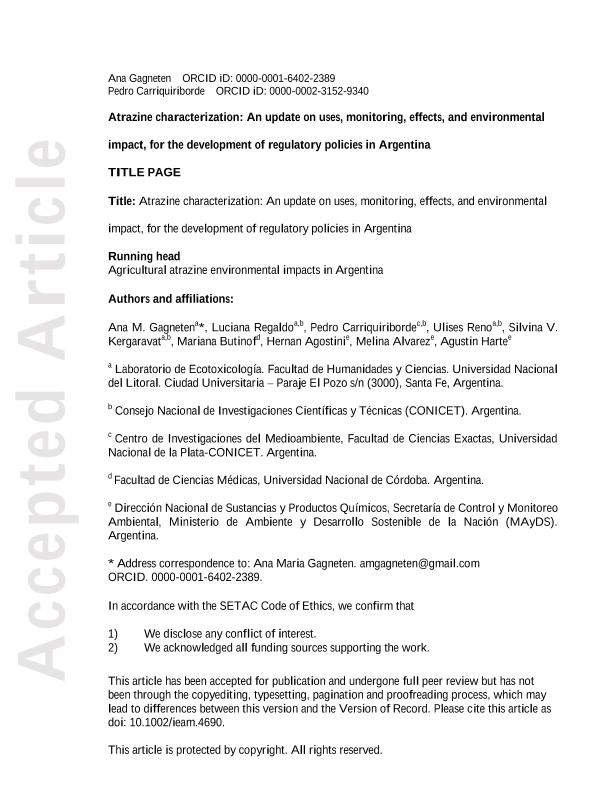Artículo
Atrazine characterization: An update on uses, monitoring, effects, and environmental impact, for the development of regulatory policies in Argentina
Gagneten, Ana María; Regaldo, Luciana María ; Carriquiriborde, Pedro
; Carriquiriborde, Pedro ; Reno, Ulises
; Reno, Ulises ; Kergaravat, Silvina Vanesa
; Kergaravat, Silvina Vanesa ; Butinof, Mariana; Agostini, Hernán Javier; Alvarez, Melina Andrea
; Butinof, Mariana; Agostini, Hernán Javier; Alvarez, Melina Andrea ; Harte, Agustin
; Harte, Agustin
 ; Carriquiriborde, Pedro
; Carriquiriborde, Pedro ; Reno, Ulises
; Reno, Ulises ; Kergaravat, Silvina Vanesa
; Kergaravat, Silvina Vanesa ; Butinof, Mariana; Agostini, Hernán Javier; Alvarez, Melina Andrea
; Butinof, Mariana; Agostini, Hernán Javier; Alvarez, Melina Andrea ; Harte, Agustin
; Harte, Agustin
Fecha de publicación:
09/2022
Editorial:
John Wiley & Sons
Revista:
Integrated Environmental Assessment and Management
ISSN:
1551-3777
e-ISSN:
1551-3793
Idioma:
Inglés
Tipo de recurso:
Artículo publicado
Clasificación temática:
Resumen
Atrazine (ATZ) is the third most widely used herbicide in Argentina (10 000 t year−1) and is approved for sugar cane, flax, corn, sorghum, and tea. An assessment of the ATZ environmental impacts was conducted at the request of the Ministry of Environment and Sustainable Development of Argentina. A review of 541 national and international technical and scientific reports and a survey among agricultural technicians, applicators, and producers was done. The survey revealed that 94% of ATZ applications are terrestrial and use diversion exists, associated mainly with soybean cultivation. Atrazine was reported at high frequencies (50%–100%) in surface and groundwater, sediments, and soils, sometimes exceeding permitted limits. Several sublethal effects induced by ATZ on invertebrate and vertebrate species were found, sometimes at concentrations lower than those in water quality guidelines (<3 µg L−1) or the environmental concentrations found in Argentina. Available epidemiological or human health studies of local populations are extremely scarce. This assessment also demonstrated that herbicides are ubiquitous in the environment. The investigation highlights the need for further studies assessing the adverse effects of ATZ on local species, ecosystems, and human health. Therefore, the precautionary principle is recommended to promote better application standards and product traceability to reduce volumes entering the environment and to avoid use deviation. In addition, this work concluded that there is a need for reviewing the toxicological classification, establishing buffer zones for ATZ application, introducing specific management guidelines, and expanding local studies of toxicity, ecotoxicity, and human epidemiology for environmental and health risk assessments. This study could also serve as a preliminary risk evaluation for establishing a final regulatory action and for considering ATZ inclusion in Annex III of the Rotterdam Convention. Finally, the requirements to consider its inclusion in Annex A (Elimination) or B (Restriction) of the Stockholm Convention were evaluated and discussed, and information on the potential of long-range transport was the only criterion with no information to consider.
Archivos asociados
Licencia
Identificadores
Colecciones
Articulos (CIM)
Articulos de CENTRO DE INVESTIGACIONES DEL MEDIO AMBIENTE
Articulos de CENTRO DE INVESTIGACIONES DEL MEDIO AMBIENTE
Articulos(CCT - SANTA FE)
Articulos de CTRO.CIENTIFICO TECNOL.CONICET - SANTA FE
Articulos de CTRO.CIENTIFICO TECNOL.CONICET - SANTA FE
Citación
Gagneten, Ana María; Regaldo, Luciana María; Carriquiriborde, Pedro; Reno, Ulises; Kergaravat, Silvina Vanesa; et al.; Atrazine characterization: An update on uses, monitoring, effects, and environmental impact, for the development of regulatory policies in Argentina; John Wiley & Sons; Integrated Environmental Assessment and Management; 19; 3; 9-2022; 684-697
Compartir
Altmétricas



